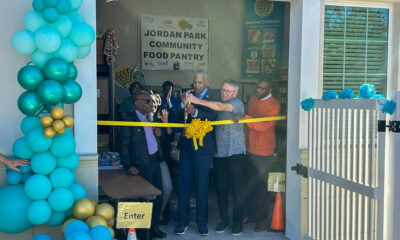Thrive
Making a difference, one starfish at a time
For Black people across America, the news over the past few weeks has been particularly grim.
In St. Petersburg, there’s the growing toll of violent crime. Since the start of the year, 15 young Black lives have been lost to homicide, 14 with guns. The suspect in each case is Black.
Hopelessness is understandable.
But at the risk of being pollyannish, maybe it’s time to pause a bit and consider some of the positive people and programs that are enveloping, guiding and inspiring the city’s Black children and young adults.
You don’t have to look hard for success.
Think Academy Prep, a nonprofit middle school founded in 1997 for economically disadvantaged boys and which, a few years later, opened its rigorous academic program to girls as well. The school, whose student body lives mostly within a two-mile radius of its campus purposely set in a Black neighborhood, is proud that 97 percent of its alumni graduate from high school and that about 75 percent continue to college or technical school or enlist in the military to serve their country.
Academy Prep’s holistic program runs 11 hours a day, six-days a week and includes three extra weeks during the summer. There are Saturday field trips, said head of school Gina Tanase Burkett. Imagine, some children in our city have never had the opportunity to go to the zoo, a museum or an aquarium. Academy Prep takes them.
The Arts Conservatory for Teens (ACT), founded by award-winning recording artist Alex Harris and his business partner Herbert Murphy to improve the lives of underserved youth by providing a broad-based arts education, is another success story. Students from the program are working on Broadway, in film, as teachers of the arts and have even started their own production companies.
ACT, which began with 30 teens in 2012, has since trained more than 2,500 young people a year in St. Petersburg, north Pinellas County and Tampa.
“As an artist, I’ve always felt that there was a lack of accessibility to under-served or under privileged youth and teens,” Harris told me, adding that he had wanted to do more than teach the arts. “I wanted to engage students in education, empowerment and enrichment, preparing them to graduate from high school with a diploma.”
Harris is firm believer in his program and doesn’t shy away from touting it: “Beyond providing a safe haven and quality before- and after-school arts programming, ACT is a holistic and interdisciplinary curriculum that combines character principles, psychology, philosophy, sociology, economics, behavioral health and technology to provide one of the most innovative and transformative approaches to youth and teen development in the 21st century,” he said.
Ernest Hooper, a former Tampa Bay Times colleague who is now vice president of communications for United Way Suncoast, spoke with me about the writing intensive program for youth he’s been working on for the past six years with Demorris Lee, another former Times colleague.
The Write Field Program at the Poynter Institute – which owns the Times – is for middle school boys. In its tenth year, the program was created after a meeting between former Poynter president Karen Brown Dunlap and the owners of the Tampa Bay Rays, its primary sponsor. The goal was to address the high dropout rate of African-American and Latino middle school boys in the city.
The Write Field has received national attention on PBS and, according to the Poynter website, has been shown to boost the grades of participants and their success in the Florida Comprehensive Test Assessment.
“What we found in our six years of co-leading this project is that infusing these kids with the power of writing can not only help them do better in school, it’s a tool to help them untangle the emotional upheaval they might be experiencing. It’s akin to keeping a journal, and some of the pieces that they have submitted are really remarkable,” Hooper said.
For example, he said, students have mentioned challenges they’re facing, whether it’s bullying, gang violence in their neighborhoods or pressure to do well in school and to be successful in life.
The boys meet at the Poynter Institute, but like almost everything, the program was forced to become virtual because of the pandemic. Still the young men were exposed to an impressive slate of speakers, including journalist Wesley Lowery of CBS News, who won a Pulitzer at the Washington Post. Jimmy Palmiotti, a leader in the world of comic books, and an illustrator and writer who rejuvenated Black Panther, was another speaker, along with Tampa Bay Rays outfielder and world series hero Brett Phillips. Screenwriter Derwin Graham also made a virtual appearance. Graham was a production assistant on The Last Dance, a documentary about Michael Jordan.
The talks are an important part of the program for the students, Hooper said, adding that like the speakers, they see that “they too can rise from their background and make something of their lives.”
Freddy Williams, president and CEO of the Boys & Girls Clubs of the Suncoast, knows what it’s like to be taken under the wing of a caring organization. He said that as a child in Panama City, he was challenged to excel by leaders at the Boys & Girls Club he attended. Today, he is intent on securing the best for the children in his charge, who range from kindergarten to 12th grade. About 85 percent of those who participate in the Suncoast clubs are Black or Hispanic, he said, with the percentage of Black members in St. Petersburg at 95.
The staff closely mirrors the demographics of the clubs and is trained to guide the children as they experience the stresses and trauma of daily life, as well as the onslaught of disturbing news on television, Williams said.
“Internally, we’re making sure that we have courageous conversations, that we are inclusive as a staff. When kids ask hard questions, we don’t ignore them. We are even bringing these courageous conversations to our board level to ensure that we’re instituting inclusive policies and practices and investing in culturally relevant programming,” he said.
Of course, we don’t need to be reminded that this is occurring amid widespread tension about race and violence right in the very neighborhoods in which some Boys & Girls Club members live.
Williams emphasizes, however, that Boys & Girls Clubs are safe places, physically and emotionally. The clubs offer mental health services to children, their parents and staff that include traditional counseling, art therapy, yoga and massage therapy.
The clubs also work with the area’s law enforcement agencies, arranging for officers to meet with teenage club members to discuss and “learn from each other’s perspectives,” Williams said, adding that “it has been really healing.”
Students get help with school work from certified teachers. Additionally, the Suncoast clubs receive financial support from United Way Suncoast, allowing them to provide certified literacy teachers at each facility. United Way funding also makes it possible to provide workforce readiness training and programs to youth.
The city also offers programs to enhance opportunities for Black and other minority children. My Brother’s and Sister’s Keeper is modeled on an initiative by former President Obama that was designed to help African-American boys. The St. Petersburg version includes young women and serves as an umbrella program for efforts to improve the safety and wellbeing of youth and their families in Black neighborhoods.
The Cohort of Champions program, for instance, focuses on educational, entrepreneurial, workforce and enrichment training for young men and young women, ages 12 to 24. Nikki Capehart, the city’s urban affairs director, and Carlos Daniels, Cohort of Champions coordinator, described it as a signature program that addresses the needs of the entire family. Parents get information about topics such as housing and financial empowerment, and families also can receive mental health referrals to a Black mental health professional.
“The wrap around that the families receive is vital to the success of this program, because we have the ability to make sure that parents are trained for better jobs if they’re under-employed or unemployed,” Capehart said Thursday. “They have the ability to get training and to be lifted up out of poverty. They have the ability to tap into emergency assistance.”
The city’s Not My Son campaign promotes achievement and anti-crime awareness, but the increase in gun violence requires an expanded effort. Capehart said there are plans to partner with the community to organize late-night street teams to connect with young people older than the 12-to-24 age range already the focus of other programs.
So, the work continues. Hooper shared a story with me this week that explains his commitment to the Write Field Program. It’s about a boy who picked up a starfish on the beach and threw it back into the ocean to save it. A man who had observed the boy told him that there were hundreds of starfish on the beach and tried to convince him that what he was doing was futile. Refusing to be deterred, the boy picked up another starfish and threw it into the ocean and said that he’d made a difference to that one.
“Maybe we can’t save the whole community, but I think we can make a difference in the 30 kids we are helping (each year),” Hooper said of the writing program.
“You just have to start with one and keep trying. What we are doing, we are just trying to save as many starfish as possible.”








Jimmy Palmiotti
April 19, 2021at12:03 pm
So happy to be able to help this wonderful positive crew. We need more love and caring in the world.